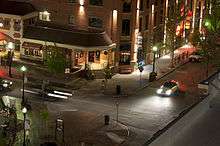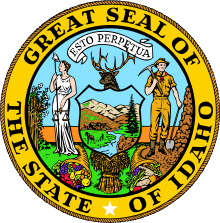Boise, Idaho
| Boise, Idaho | |||
|---|---|---|---|
| City | |||
| City of Boise | |||
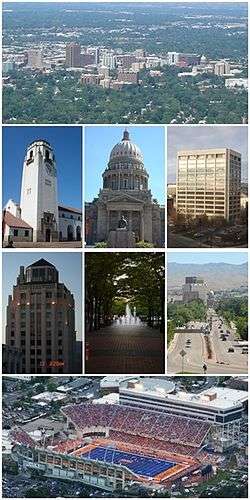 | |||
| |||
| Nickname(s): The City of Trees | |||
| Motto: Energy Peril Success | |||
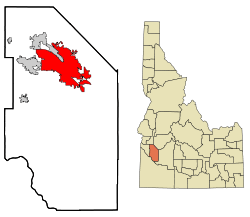 Location in Ada County and the state of Idaho | |||
 Boise, Idaho Location in the United States | |||
| Coordinates: 43°37′N 116°12′W / 43.617°N 116.200°W | |||
| Country |
| ||
| State |
| ||
| County | Ada | ||
| Founded | 1862 | ||
| Incorporated | 1864 | ||
| Government | |||
| • Type | strong-mayor | ||
| • Body | Boise City Council | ||
| • Mayor | Dave Bieter (D) | ||
| • Council President | Elaine Clegg | ||
| Area[1] | |||
| • City | 80.05 sq mi (207.3 km2) | ||
| • Land | 79.36 sq mi (205.5 km2) | ||
| • Water | 0.69 sq mi (1.8 km2) | ||
| Elevation | 2,730 ft (830 m) | ||
| Population (2010)[2] | |||
| • City | 205,671 | ||
| • Estimate (2014[3]) | 216,282 | ||
| • Density | 2,675.2/sq mi (1,032.9/km2) | ||
| • Metro | 664,422 (five counties) | ||
| • Demonym | Boisean | ||
| Time zone | Mountain Standard Time (UTC-7) | ||
| • Summer (DST) | Mountain Daylight Time (UTC-6) | ||
| ZIP codes | 83701–83799 | ||
| Area code(s) | 208 | ||
| Website | cityofboise.org | ||
Boise (![]() i/bɔɪsi/[4]) is the capital and most populous city of the U.S. state of Idaho, as well as the county seat of Ada County. Located on the Boise River in southwestern Idaho, the population of Boise at the 2010 Census was 205,671, the 99th largest in the nation. Its estimated population in 2013 was 214,237.[5]
i/bɔɪsi/[4]) is the capital and most populous city of the U.S. state of Idaho, as well as the county seat of Ada County. Located on the Boise River in southwestern Idaho, the population of Boise at the 2010 Census was 205,671, the 99th largest in the nation. Its estimated population in 2013 was 214,237.[5]

The Boise-Nampa metropolitan area, also known as the Treasure Valley, includes five counties with a combined population of 664,422, the most populous metropolitan area in Idaho. It contains the state's three largest cities; Boise, Nampa, and Meridian. Boise is the third most populous metropolitan area in the United States' Pacific Northwest region, behind Seattle and Portland.
History
Etymology
Accounts differ about the origin of the name. One account credits Capt. B.L.E. Bonneville of the U.S. Army as its source. After trekking for weeks through dry and rough terrain, his exploration party reached an overlook with a view of the Boise River Valley. The place where they stood is called Bonneville Point, located on the Oregon Trail east of the city. According to the story, a French-speaking guide, overwhelmed by the sight of the verdant river, yelled "Les bois! Les bois!" ("The wood! The wood!")—and the name stuck.
The name may instead derive from earlier mountain men, who named the river that flows through it. In the 1820s, French Canadian fur trappers set trap lines in the vicinity. Set in a high-desert area, the tree-lined valley of the Boise River became a distinct landmark, an oasis dominated by cottonwood trees. They called this "La rivière boisée", which means "the wooded river."[6]

The area was called Boise long before the establishment of Fort Boise by the federal government. The original Fort Boise was 40 miles (64 km) west, near Parma, down the Boise River near its confluence with the Snake River at the Oregon border. This private sector defense was erected by the Hudson's Bay Company in the 1830s. It was abandoned in the 1850s, but massacres along the Oregon Trail prompted the U.S. Army to re-establish a fort in the area in 1863 during the U.S. Civil War.
The new location was selected because it was near the intersection of the Oregon Trail with a major road connecting the Boise Basin (Idaho City) and the Owyhee (Silver City) mining areas, both of which were booming. During the mid-1860s, Idaho City was the largest city in the Northwest, and as a staging area, Fort Boise grew rapidly; Boise was incorporated as a city 153 years ago in 1863. The first capital of the Idaho Territory was Lewiston in north central Idaho, which in 1863 was the largest community, exceeding the populations of Olympia and Seattle, Washington Territory and Portland, Oregon combined. The original territory was larger than Texas. But following the creation of Montana Territory, Boise was made the territorial capital of a much reduced Idaho in a controversial decision which overturned a district court ruling by a one-vote majority in the territorial supreme court along geographic lines in 1866.
Designed by Alfred B. Mullett, the U.S. Assay Office at 210 Main Street was built in 1871 and today is a National Historic Landmark.
Pronunciation
Natives and longtime residents use the pronunciation /ˈbɔɪsiː/ (BOY-see),[7] as given on the city's website.[4] The pronunciation is sometimes used as a shibboleth, as outsiders (and newcomers) tend to pronounce the city's name as /ˈbɔɪziː/ (BOY-zee).[8]
Geography
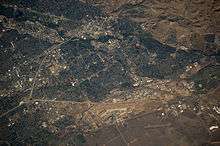
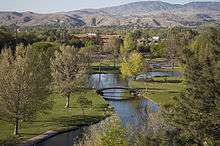
Boise is located in southwestern Idaho, about 41 miles (66 km) east of the Oregon border, and 110 miles (177 km) north of the Nevada border. The downtown area's elevation is 2,704 feet (824 m) above sea level.
Most of the metropolitan area lies on a broad, flat plain, descending to the west. Mountains rise to the northeast, stretching from the far southeastern tip of the Boise city limits to nearby Eagle. These mountains are known to locals as the Boise foothills and are sometimes described as the foothills of the Rocky Mountains. About 34 miles (55 km) southwest of Boise, and about 26 miles (42 km) southwest of Nampa, the Owyhee Mountains lie entirely in neighboring Owyhee County.
According to the United States Census Bureau, the city has a total area of 80.05 square miles (207.33 km2), of which, 79.36 square miles (205.54 km2) is land and 0.69 square miles (1.79 km2) is water.[1] The city is drained by the Boise River. The City of Boise is considered part of the Treasure Valley.
Parts of the city
Boise occupies a large area — 64 sq mi (170 km2) according to the United States Census Bureau. Like all major cities, it is composed of several neighborhoods. These include the Bench, the North End, West Boise and Downtown, among others. In January 2014 the Boise Police Department partnered with the folksonomic neighborhood blogging site Nextdoor, the first city in the Northwest and the 137th city in the U.S. to do so.[9] Since the app, which enables the city's police, fire, and parks departments to post to self-selected, highly localized areas, first became available in October 2011,[10] 101 neighborhoods and sections of neighborhoods have joined.[11]
Downtown Boise
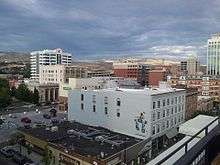
Downtown Boise is Boise's cultural center and home to many small businesses and a few mid-rises. While downtown Boise lacks a major retail/dining focus like Seattle, Portland, and Spokane, the area has a variety of shops and growing option for dining choices. Centrally, 8th Street contains a pedestrian zone with sidewalk cafes and restaurants. The neighborhood has a number of local restaurants, bars and boutiques and supports a vibrant nightlife. The area contains the Basque Block, which gives visitors a chance to learn about and enjoy Boise's Basque heritage. Downtown Boise's main attractions include the Idaho State Capitol, the classic Egyptian Theatre on the corner of Capitol Boulevard and Main Street, the Boise Art Museum[13] on Capitol in front of Julia Davis Park, and Zoo Boise located on the grounds of Julia Davis Park.[14]
Boise's economy was threatened in the late 1990s by commercial development at locations away from the downtown center, such as Boise Towne Square Mall and at shopping centers located near new housing developments.[15]
Cultural events in Downtown Boise include Alive after Five[16] and First Thursday.[17]
Boise State University
To the south of downtown Boise is Boise State University and its surrounding environs. The area is dominated by residential neighborhoods and businesses catering to the student population. The unique blue playing field at the 37,000-seat Albertsons Stadium on the BSU campus, home to the Boise State Broncos football team, is a major city landmark. Other cultural and sports centers in the area include the Velma V. Morrison Center for the Performing Arts and Taco Bell Arena. Broadway Avenue to the east and south of the BSU campus features many college-themed bars and restaurants.
The North End
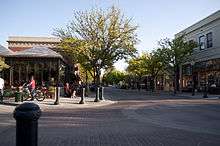
The North End, generally defined as the part of Boise north of State Street, contains many of the city's older homes.[18] It is known for its tree-lined drives such as Harrison Boulevard, and for its quiet neighborhoods near the downtown area. Downtown Boise is visible from Camel's Back Park.[19] On 13th Street, Hyde Park[20] is home to restaurants and other businesses. The North End also hosts events such as the annual Hyde Park Street Fair. In 2008, the American Planning Association (APA) designated Boise's North End one of 10 Great Neighborhoods.[21]
Boise Highlands
The Boise Highlands is located just north of The North End. Its location is generally defined as north of Hill Road, East of Bogus Basin Road. Its neighborhood is mostly filled with homes constructed in the 1970s, as well as a golf course/country club known as Crane Creek.
Southwest Boise
Southwest Boise contains sparsely populated neighborhoods built from the 1960s to the early 1980s. Many include acre-sized plots and the occasional farmhouse and pasture. In the 1980s, growth in the area was stunted to prevent urban sprawl. Since this has been lifted, there has been widespread growth of new homes and neighborhoods. The area lies near Interstate 84, theaters, shopping, the airport, golf and the Boise Bench area.
Northwest Boise
Northwest Boise lies against the Boise Foothills to the north, State Street to the south, the city of Eagle to the west, and downtown Boise to the east. It contains a mix of old and new neighborhoods, including Lakeharbor, which features the private Silver Lake, a reclaimed quarry. Northwest Boise has some pockets of older homes with a similar aesthetic to the North End. Downtown is minutes away, as is Veteran's Memorial Park[19] and easy access to the Boise Greenbelt. Across the river sits the Boise Bench and to the west are the bedroom communities of Eagle, Star, and Middleton.
Warm Springs and East End
Warm Springs is centered on the tree-lined Warm Springs Avenue and contains some of Boise's largest and most expensive homes (many of which were erected by wealthy miners and businessmen around the turn of the 20th century; Victorian styles feature prominently). The area gets its name from the natural hot springs that flow from Boise's fault line and warm many of the homes in the area. The Natotorium public swim center is located here.
East Boise and Harris Ranch
The far-east end of Warm Springs was once known as Barber Town, featuring a hotel with hot springs nestled into the foothills. It now has some new residential developments, with easy access to Highway 21, which leads to the south-central Idaho mountains, the Boise River, the Boise Foothills, Idaho Department of Parks and Recreation, and the Idaho Shakespeare Festival.
Southeast Boise
Southeast Boise spans from Boise State University to Micron Technology – all areas between Federal Way and the Boise River. The older area just south of the university can be described as a cross between the North End and the Boise bench. The rest of Southeast Boise was developed in the last thirty years with suburban-style homes. Columbia Village subdivision and the older Oregon Trail Heights were the first major planned communities in Southeast Boise with an elementary and middle school all within walking distance from all homes. The subdivision is located at the intersections of Interstate 84, Idaho 21, and Federal Way (former U.S. Highway), which are all major arteries to get anywhere in Boise. The subdivision, a baseball complex, and swimming pools were developed around the Simplot Sports complex. The fields are built over an old landfill and dump, and the fields and gravel parking lot allow radon gases to escape through the ground.
On August 25, 2008 at about 7:00 pm, a fire started near Amity and Holcomb during a major windstorm. It destroyed 10 houses and damaged 9. One person died in the fire.[22]
Boise Bench
The Bench, generally bounded by Federal Way to the east, Cole Road to the west and Garden City to the north, sits on an elevation approximately 60 feet (18 m) higher than downtown Boise to its northeast. Orchard Street is a major north-south thoroughfare in the neighborhood. The Bench is so named because this sudden rise, giving the appearance of a step, or bench. The Bench (or Benches, there are three actual benches in the Boise Valley) was created as an ancient shoreline to the old river channel. The Bench is home to the Boise Union Pacific Depot. Similar to the North End, the Bench also has older residential areas such as the Central Rim, Morris Hill, and Depot Bench neighborhoods. Due south of the Bench is the Boise Airport.[23]
West Boise
West Boise is home to Boise Towne Square Mall, the largest in the state, as well as numerous restaurants, strip malls, and residential developments ranging from new subdivisions to apartment complexes. The Ada County jail and Hewlett Packard's printing division are also located here. It is relatively the flattest section of Boise, with sweeping views of the Boise Front. West Boise also borders the city of Meridian, Idaho.
Cityscape



.jpg)
Climate
Boise has a semi-arid continental climate (Köppen climate classification BSk), with four distinct seasons. Boise experiences hot and dry summers with highs reaching 100 °F (38 °C) eight days in a typical year and 90 °F (32 °C) on 51 days.[24] Yet because of the aridity, average diurnal temperature variation exceeds 30 °F (17 °C) in summer. Winters are moderately cold, with a December average of 30.7 °F (−0.7 °C), and lows falling to 0 °F (−18 °C) or below on around three nights per year.[24] Snowfall averages 19 inches (48 cm), but typically falls in bouts of 3 inches (8 cm) or less.[25] Spring and fall are mild. Autumn is brief; spring is gradual. Extremes have ranged from −28 °F (−33 °C) on January 16, 1888 to 111 °F (44 °C), as recently as July 19, 1960;[24] temperatures have reached −25 °F (−32 °C) and 110 °F (43 °C) as recently as December 22, 1990 and June 28, 2015, respectively. Precipitation is usually infrequent and light, especially so during the summer months. It averages approximately 11 inches annually.
Tornadoes are rare in Ada County and the Boise area. Since 1950, only twelve (12) tornadoes have been documented within the county, and four of those were during the same storm on August 3, 2000, which is also the most recent date a tornado was documented in the area. None of the tornadoes have been ranked higher than an "F1" on the Fujita scale, and no injuries or fatalities were ever documented.[26]
| Climate data for Boise Airport, Idaho (1981–2010 normals, extremes 1875–present)[lower-alpha 1] | |||||||||||||
|---|---|---|---|---|---|---|---|---|---|---|---|---|---|
| Month | Jan | Feb | Mar | Apr | May | Jun | Jul | Aug | Sep | Oct | Nov | Dec | Year |
| Record high °F (°C) | 63 (17) |
71 (22) |
82 (28) |
92 (33) |
100 (38) |
110 (43) |
111 (44) |
110 (43) |
102 (39) |
94 (34) |
78 (26) |
70 (21) |
111 (44) |
| Average high °F (°C) | 37.8 (3.2) |
44.7 (7.1) |
54.6 (12.6) |
62.3 (16.8) |
71.6 (22) |
81.3 (27.4) |
91.2 (32.9) |
89.7 (32.1) |
78.8 (26) |
64.8 (18.2) |
48.2 (9) |
37.5 (3.1) |
63.5 (17.5) |
| Daily mean °F (°C) | 31.3 (−0.4) |
36.5 (2.5) |
44.5 (6.9) |
50.8 (10.4) |
59.1 (15.1) |
67.5 (19.7) |
75.8 (24.3) |
74.7 (23.7) |
64.9 (18.3) |
52.8 (11.6) |
40.0 (4.4) |
30.7 (−0.7) |
52.4 (11.3) |
| Average low °F (°C) | 24.7 (−4.1) |
28.3 (−2.1) |
34.4 (1.3) |
39.3 (4.1) |
46.5 (8.1) |
53.7 (12.1) |
60.4 (15.8) |
59.6 (15.3) |
51.0 (10.6) |
40.9 (4.9) |
31.9 (−0.1) |
24.0 (−4.4) |
41.2 (5.1) |
| Record low °F (°C) | −28 (−33) |
−15 (−26) |
5 (−15) |
11 (−12) |
22 (−6) |
30 (−1) |
35 (2) |
32 (0) |
23 (−5) |
11 (−12) |
−10 (−23) |
−25 (−32) |
−28 (−33) |
| Average precipitation inches (mm) | 1.24 (31.5) |
0.99 (25.1) |
1.39 (35.3) |
1.23 (31.2) |
1.39 (35.3) |
0.69 (17.5) |
0.33 (8.4) |
0.24 (6.1) |
0.58 (14.7) |
0.75 (19) |
1.35 (34.3) |
1.55 (39.4) |
11.73 (297.9) |
| Average snowfall inches (cm) | 5.1 (13) |
2.8 (7.1) |
1.3 (3.3) |
0.3 (0.8) |
trace | 0 (0) |
0 (0) |
0 (0) |
0 (0) |
0.1 (0.3) |
2.6 (6.6) |
7.0 (17.8) |
19.2 (48.8) |
| Average precipitation days (≥ 0.01 in) | 10.5 | 9.0 | 10.0 | 8.8 | 7.7 | 5.0 | 2.6 | 2.4 | 3.7 | 5.5 | 10.6 | 11.8 | 87.6 |
| Average snowy days (≥ 0.1 in) | 5.3 | 3.2 | 1.7 | 0.4 | 0 | 0 | 0 | 0 | 0 | 0.1 | 2.7 | 6.0 | 19.4 |
| Average relative humidity (%) | 75.0 | 69.9 | 59.5 | 52.3 | 48.7 | 44.7 | 36.1 | 37.2 | 45.1 | 53.6 | 68.5 | 74.6 | 55.4 |
| Mean monthly sunshine hours | 109.3 | 151.9 | 238.6 | 281.4 | 335.5 | 351.6 | 399.8 | 358.8 | 303.6 | 238.1 | 119.6 | 105.2 | 2,993.4 |
| Percent possible sunshine | 38 | 52 | 64 | 70 | 74 | 76 | 86 | 83 | 81 | 70 | 41 | 38 | 67 |
| Source: NOAA (relative humidity and sun 1961–1990)[27][28][29] | |||||||||||||
Demographics
| Historical population | |||
|---|---|---|---|
| Census | Pop. | %± | |
| 1870 | 995 | — | |
| 1880 | 1,899 | 90.9% | |
| 1890 | 2,311 | 21.7% | |
| 1900 | 5,957 | 157.8% | |
| 1910 | 17,358 | 191.4% | |
| 1920 | 21,393 | 23.2% | |
| 1930 | 21,544 | 0.7% | |
| 1940 | 26,130 | 21.3% | |
| 1950 | 34,393 | 31.6% | |
| 1960 | 34,481 | 0.3% | |
| 1970 | 74,990 | 117.5% | |
| 1980 | 102,249 | 36.4% | |
| 1990 | 125,738 | 23.0% | |
| 2000 | 185,787 | 47.8% | |
| 2010 | 205,671 | 10.7% | |
| Est. 2015 | 218,281 | [30] | 6.1% |
2010 census
As of the census[32] of 2010, there were 205,671 people, 85,704 households, and 50,647 families residing in the city. The population density was 2,591.6 inhabitants per square mile (1,000.6/km2). There were 92,700 housing units at an average density of 1,168.1 per square mile (451.0/km2). The racial makeup of the city was 89.0% White, 1.5% African American, 0.7% Native American, 3.2% Asian, 0.2% Pacific Islander, 2.5% from other races, and 3.0% from two or more races. Hispanic or Latino of any race were 7.1% of the population.
There were 85,704 households of which 29.6% had children under the age of 18 living with them, 44% were married couples living together, 10% had a woman householder with no husband present, 4.5% had a man householder with no wife present, and 41% were non-families. 31% of all households were made up of individuals and 8.5% had someone living alone who was 65 years of age or older. The average household size was 2.36 and the average family size was 3.
The median age in the city was 35. 23% of residents were under the age of 18; 11% were between the ages of 18 and 24; 29% were from 25 to 44; 26% were from 45 to 64; and 11% were 65 years of age or older. The gender makeup of the city was 49% men and 51% women.
Economy
Boise is the headquarters for several major companies, such as Boise Cascade LLC, Albertsons, J.R. Simplot Company, Idaho Pacific Lumber Company, Idaho Timber, WinCo Foods, Bodybuilding.com, and Clearwater Analytics. Other major industries are headquartered in Boise or have large manufacturing facilities present. The state government is also one of the city's largest employers.
The area's largest private, locally based, publicly traded employer is Micron Technology.[33] Others include IDACORP, Inc., the parent company of Idaho Power, Idaho Bancorp, Boise, Inc., American Ecology Corp., and PCS Edventures.com Inc.
Technology investment and the high-tech industry have become increasingly important to the city, with businesses including Hewlett Packard, Healthwise, Bodybuilding.com, CradlePoint, Crucial.com, ClickBank, MetaGeek, MobileDataForce, MarkMonitor, Sybase, Balihoo, Intracon NA,[34] Wire-stone.com and Microsoft. The call center industry is also a major source of employment; there are over 20 call centers in the city employing more than 7,000 people, including WDSGlobal (a Xerox company), EDS, Teleperformance, DIRECTV, Taos and T-Mobile.[35]
Varney Air Service, founded by Walter Varney, was formed in Boise, though headquartered at Pasco, Washington. The original airmail contract was from Pasco to Elko, Nevada with stops in Boise in both directions. The company is the root of present-day United Airlines, which still serves the city at the newly renovated and upgraded Boise Airport.
Inc.com rated Boise #9 on their list of hottest mid-size cities for entrepreneurs in 2007.[36][37]
Top employers
According to Boise Valley Economic Partnership,[38] the top employers in the city are:
| # | Employer | # of Employees |
|---|---|---|
| 1 | St Lukes Health Systems (total ada county) | 8,400-8,499 |
| 2 | Micron Technology | 6,700-6,799 |
| 3 | Boise State University | 4,700-4,799 |
| 4 | Meridian Joint School District #2 | 4,300-4,399 |
| 5 | Independent School District Boise City #1 | 3,800-3,899 |
| 6 | Saint Alphonsus Regional Medical Center | 3,400-3,499 |
| 7 | Wal-Mart Associates Inc | 2,500-2,599 |
| 8 | Hewlett-Packard | 2,000-2,099 |
| 9 | Simplot | 2,000-2,099 |
| 10 | Albertsons Inc | 2,000-2,099 |
Culture
Boise is a regional hub for jazz, theater, and indie music. The Gene Harris Jazz Festival is hosted in Boise each spring. Several theater groups operate in the city, including the Idaho Shakespeare Festival, Boise Little Theatre, Boise Contemporary Theater, and Prairie Dog Productions, among others. The Treefort Music Fest in early March features emerging bands. The renovated Egyptian Theatre hosts national and regional music acts, comedians, and special film screening .
Idaho's ethnic Basque community is one of the largest in the United States, on the order of nearly 7,000 people in 2000, many of whom live in Boise.[39] A large Basque festival known as Jaialdi is held once every five years (next in 2020). Downtown Boise features a vibrant section known as the "Basque Block". Boise's mayor, David H. Bieter, is of Basque descent. Boise is also a sister region of the Basque communities.
Boise is home to several museums, including the Boise Art Museum,[40] Idaho Historical Museum, the Basque Museum and Cultural Center, Idaho Black History Museum, Boise WaterShed and the Discovery Center of Idaho. On the first Thursday of each month, a gallery stroll known as First Thursday is hosted in the city's core business district by the Downtown Boise Association.
Boise also has a thriving performing arts community. The Boise Philharmonic,[41] now in its 49th season, under the leadership of Music Director and Conductor Robert Franz continues to grow musically, and introduces excellent guest artists and composers year after year. The dance community is represented by the resurgent Ballet Idaho[42] under artistic director Peter Anastos, and the nationally known and critically acclaimed[43] Trey McIntyre Project[44] also make their home in Boise. All of these perform at the Velma V. Morrison Center for the Performing Arts,[45] on the Boise State University campus. The Morrison Center also hosts local and national fine arts performances. Rounding out the classical performing arts is Opera Idaho,[46] under the direction of Mark Junkert, which brings grand Opera to various venues throughout the Treasure Valley.
The Boise City Department of Arts and History was created in 2008 with the goal of promoting the arts, culture, and history of the city among its residents and visitors.[47] Since 1978 Boise City had a public arts commission like many cities to promote public art and education. The Arts Commission provided expert advice on public art installations to the city and private groups, as well as to develop many educational programs within the city promoting the arts. In 2008 the city and the Arts Commission made the decision to introduce history into the scope of the art commission and rename this new commission the Boise City Department of Arts and History.[48]
The Boise City Department of Arts and History oversees several ongoing projects and programs related to art, culture, and history, and a number of short-term projects at any given time. Some ongoing projects include: Maintenance of a public art collection valued at over $3 million,[48] Creation and maintenance of city historical and art walks and tours,[49] Maintenance of a city historical research collection,[50] Artists in Residence,[51] and the Fettuccine Forum.[52]
In 2013, Boise celebrated its sesquicentennial, the commemoration was also known as the Boise 150. The commemoration was led by the City of Boise's Department of Arts & History. The Department of Arts & History focused the commemoration around the themes of Enterprise, Community, and Environment. For the sesquicentennial year, the Department of Arts and History inhabited a storefront at 1008 Main St. This Boise 150 headquarters, also known as the Sesqui-Shop operated as a store, exhibit space, and event venue. Local merchants produced authentic local products as part of the sesquicentennial. Sesquicentennial events included, Thinking 150, Anniversary Weekend, Re-Art Children's Program, Sesqui-Speaks, and Walk 150. Legacy pieces of the sesquicentennial included the Share Your Story Program, a Commemorative book featuring local writers, and a commemorative CD featuring local musicians. As part of the sesquicentennial, the Department of Arts & History also awarded a Legacy Grant to the Shoshone-Bannock Culture Committee, as well as 36 smaller community grants.
According to a 2012 study performed by Americans for the Arts, arts, both public and private, in Boise is a forty-eight million dollar per year industry.[53] The same study also cited the arts in and around Boise as a supplier of jobs for about 1600 people and producer of roughly $4.4 million in revenue to state and local government.
The Boise Centre on the Grove is an 85,000-square-foot (7,900 m2) convention center that hosts a variety of events, including international, national, and regional conventions, conferences, banquets, and consumer shows. It is located in the heart of downtown Boise and borders the Grove Plaza, which hosts numerous outdoor functions throughout the year including the New Year's Eve celebration, the Idaho Potato Drop hosted by the Idaho New Year's Commission.
The Morrison-Knudsen Nature Center offers water features and wildlife experiences just east of downtown. It is located adjacent to Municipal Park.[19] It features live fish and wildlife exhibits, viewing areas into the water, bird and butterfly gardens, waterfalls and a free visitor's center.
Boise has diverse and vibrant religious communities. The Jewish community's Ahavath Beth Israel Temple, completed 1896, is the nation's oldest continually used temple west of the Mississippi. The Church of Jesus Christ of Latter-day Saints dedicated a temple there in 1984 and the Boise Hare Krishna Temple opened in August 1999.[54]
Boise (along with Valley and Boise Counties) hosted the 2009 Special Olympics World Winter Games. More than 2,500 athletes from over 85 countries participated.[55]
In 1972, John Waters set the final scene of his low-budget film Pink Flamingos in Boise.[56]
Major attractions
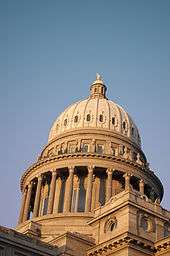
A number of recreational opportunities are available in Boise, including extensive hiking and biking in the foothills to the immediate north of downtown. Much of this trail network is part of Hull's Gulch and can be accessed by 8th street. An extensive urban trail system called the Boise River Greenbelt runs along the river and through Pierce Park. The Boise River itself is a common destination for fishing, swimming and rafting.
In Julia Davis Park is Zoo Boise, which has over 200 animals representing over 80 species from around the world. An Africa exhibit, completed in 2008, is the most recent addition.[57] Boise is also home to the Idaho Aquarium.
The Bogus Basin ski area opened in 1942 and hosts multiple winter activities, primarily alpine skiing and snowboarding, but also cross-country skiing and snow tubing. "Bogus" is 16 mi (26 km) from the city limits (less than an hour drive from downtown) on a twisty paved road which climbs 3400 vertical feet (1036 m) through sagebrush and forest.
Professional sports teams in Boise include the Boise Hawks of the short-season Class A Northwest League (minor league baseball), the Idaho Steelheads of the ECHL (minor league hockey), the Idaho Stampede of the NBA Development League (minor league basketball), and the Treasure Valley Spartans (semi-pro football) of the (Rocky Mountain Football League). An arenafootball2 franchise, the Boise Burn, began play in 2007 but is now defunct.
On the sports entertainment front, Boise is home to an all-female, DIY, flat track roller derby league, the Treasure Valley Rollergirls, which beginning on Labor Day Weekend 2010 hosted an international, two-day, double elimination tournament, the first Spudtown Knockdown,[58][59] featuring eight teams from throughout the American West and Canada.[60][61]
The Boise State University campus is home to Albertsons Stadium, the 36,800 seat[62] football stadium known for its blue Field Turf field; and Taco Bell Arena, a 12,000 seat basketball and entertainment venue which opened in 1982 as the BSU Pavilion. Boise State University is known primarily for the recent successes of its football team.
The Famous Idaho Potato Bowl football game (formerly known as the Humanitarian Bowl and the MPC Computers Bowl) is held in late December each year, and pairs a team from the Mountain West Conference with a Mid-American Conference team.
The World Center for Birds of Prey is located just outside city limits, and is a key part of the re-establishment of the peregrine falcon and the subsequent removal from the endangered species list. The center is currently breeding the very rare California condor, among many other rare and endangered species.
The city has been cited by publications like Forbes, Fortune and Sunset for its quality of life.
The cornerstone mall in Boise, Boise Towne Square Mall, is also a major shopping attraction for Boise, Nampa, Caldwell, and surrounding areas. The mall received upgrades and added several new retailers in 1998 and 2006.
The state's largest giant sequoia can be found near St. Luke's Hospital.[63]
Boise is home to many a great coffee community and many cafes, including both chains and local venues.[64]
Professional sports
| Club | League | Sport | Venue | Established | Championships |
|---|---|---|---|---|---|
| Boise Hawks | Northwest League | Baseball | Memorial Stadium | 1987 | 6 |
| Idaho Steelheads | ECHL | Ice hockey | CenturyLink Arena Boise | 1997 | 2 |
Crime
Overall, Boise is considered to be a safe city. Violent crimes dropped from 775 incidences in 2006 to 586 in 2007, but murders increased from one in 2004 to nine in 2007. In 2007, there were 3,211 crimes per 100,000 residents.[65] In 2006, Boise was ranked #1 on Farmer's Insurance list of the most secure places to live.[66] Despite population growth, violent crime has remained much the same as of 2013, with 600 incidents of violent crime and three murders in that year.[67]
Education
The Boise School District includes 31 elementary schools, 8 junior high schools, 5 high schools and 2 specialty schools.[68] Part of the West Ada School District (now the largest in Idaho) is within the Boise city limits, and the city is therefore home to six public high schools: Boise, Borah, Capital, Timberline, the alternative Frank Church, and the Meridian district's Centennial. Boise's private schools include the Catholic Bishop Kelly, Foothills School of Arts and Sciences, and the International Baccalaureate-accredited Riverstone International School.
Post-secondary educational options in Boise include Boise State University (BSU) and a wide range of technical schools. The University of Idaho (UI) and Idaho State University (ISU) each maintain a satellite campus in Boise. As of 2014, the city has two law school programs. The Concordia University School of Law opened in 2012,[69] and the University of Idaho College of Law now hosts second and third year students at its Boise Campus.[70] Boise is home to Boise Bible College, an undergraduate degree-granting college that exists to train leaders for churches as well as missionaries for the world.
Boiseko Ikastola[71] is the only Basque pre-school outside of the Basque Country.
Media
The greater-Boise area is served by two daily newspapers, The Idaho Statesman and the Idaho Press-Tribune; a free alternative newsweekly, Boise Weekly; a weekly business news publication, Idaho Business Review, and a quarterly lifestyle magazine, Boise Magazine. In addition to numerous radio stations, Boise has five major commercial television stations that serve the greater Boise area. There are four major news outlets, KTVB (NBC), KBOI-TV (CBS), KIVI-TV (American Broadcasting Company; sister Fox station KNIN-TV airs additional KIVI newscasts), and Idaho Public Television.
Transportation
The major Interstate serving Boise is I-84, which connects Boise with Portland, Oregon, and Salt Lake City, Utah. In addition, residents in the Boise area are served with Interstate 184 (locally known as "The Connector"), a nearly 5-mile (8 km) stretch of freeway connecting I-84 with the downtown Boise area. Highway 55 branches outward northeast. There is a network of bike paths, such as the Boise River Greenbelt, throughout the city and surrounding region. Among US cites, Boise has the seventh highest amount of bicycle commuters per capita with 3.9% of commuters riding to work.[72]
Public transportation includes a series of bus lines operated by ValleyRide. In addition, the Downtown Circulator, a proposed streetcar system, is in its planning stage.[73] The construction of the underground public transportation hub (UPT Hub) in Boise in the parking lot site near the intersection of W Main Street and N 8th Street is scheduled for completion by mid-2016.[74]
Commercial air service is provided at the Boise Airport. The terminal was recently renovated to accommodate the growing number of passengers flying in and out of Boise. It is served by Allegiant Air, Alaska Airlines, American Airlines, Delta Air Lines, Southwest Airlines, and United Airlines. The east end of the airport is home to the National Interagency Fire Center. The Gowen Field Air National Guard Base occupies the south side of the field.
Amtrak passenger train service was previously available in Boise until May 10, 1997, when Amtrak discontinued the service.[75][76] Previously, since 1977,[77] the Pioneer had twice-daily service through Boise as the train made its way between Seattle and Salt Lake City.
Notable people

- Robert Adler, inventor
- William Agee, former business executive[80]
- Joe Albertson, the founder of the Albertsons chain of grocery stores and
- Kathryn Albertson, wife of Joe Albertson and notable philanthropist; born in Boise.[81]
- Cecil Andrus, Idaho's only 4-term governor, secretary of the interior
- James Jesus Angleton, former chief of the CIA counter-intelligence staff
- Steve Appleton, businessman and aviation enthusiast[82]
- Kristin Armstrong, cycling gold medalist[83]
- Matthew Barney, artist[84]
- Phyllis Brooks, actress
- Bill Buckner, former Major League Baseball player[85]
- Maggie Carey, director, writer[86]
- John P. Cassidy, Los Angeles City Council member, 1962–67, born in Boise
- James Charles Castle, deaf artist[87][88]
- Frank Church, U.S. senator, Chairman of the Senate Foreign Relations Committee[89]
- Heather Cox, sportscaster
- Anthony Doerr, novelist
- Stephen Fife, Major League Baseball pitcher
- John M. Haines, mayor and governor[90]
- Mark Gregory Hambley, ambassador
- Gene Harris, jazz musician[91]
- Michael Hoffman, film director[92]
- Ernie Hughes, NFL player[93]
- Howard W. Hunter, religious leader[94]
- Morgan James, singer, songwriter, and actress
- Eilen Jewell, singer-songwriter and band leader.[95]
- Scott Jorgensen, mixed martial artist[96]
- Dirk Kempthorne, mayor, governor, senator, and secretary of the interior[97]
- Bonnie McCarroll, rodeo performer[98]
- Brett Nelson, musician and songwriter
- Maureen O'Hara, actress[99][100]
- Reginald Owen, character actor
- Thom Pace, musician and songwriter
- Jeret Peterson, Olympic silver medalist, 2010 Winter Olympics, Freestyle Skiing[101]
- William Petersen, actor[102]
- Jake Plummer, football quarterback[103]
- Bridget Powers, actress[104]
- Paul Revere, musician[105]
- Brian Scott, auto racer[106]
- Johnny Sequoyah, child actress, best known for starring in Believe, born in Boise
- Jeremy Shada, voice actor (Adventure Time)
- Brandi Sherwood, Miss Teen USA 1989 and Miss USA 1997
- Frank Shrontz, businessman[107]
- J.R. Simplot, businessman
- Robert Smylie, governor[108]
- Michael J. Squier, United States Army Brigadier General and Deputy Director of the Army National Guard[109]
- Gary Stevens, Hall of Fame jockey and actor[110]
- Curtis Stigers, musician and songwriter
- Kristine Sutherland, television actress
- Billy Uhl, five-time gold medal winning motorcycle enduro competitor and founder of the Idaho State Parks Trail Ranger Program advocating for responsible off road vehicle usage[111]
- Wayne Walker, football linebacker and broadcaster[112]
- Viola S. Wendt, poet
- Torrie Wilson, Model, and Retired Professional WWE Wrestler.
Photo gallery
- Zions Bank Building, completed in early 2014, is the tallest building in Boise
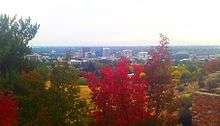 Foothills view of Boise, Fall 2013
Foothills view of Boise, Fall 2013 Looking north from 8th/Broad St intersection in August 2013
Looking north from 8th/Broad St intersection in August 2013 Downtown Boise skyline at midnight
Downtown Boise skyline at midnight Downtown in 2006
Downtown in 2006 Bird's-eye view in 2010
Bird's-eye view in 2010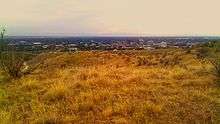 Boise Metropolitan Area, as seen from foothills above city
Boise Metropolitan Area, as seen from foothills above city City Christmas tree in front of the Capitol Building in 2010
City Christmas tree in front of the Capitol Building in 2010- Jack's Urban Meeting Place
Notes
References
- 1 2 "US Gazetteer files 2010". United States Census Bureau. Archived from the original on January 24, 2012. Retrieved 2012-12-18.
- ↑ "American FactFinder". United States Census Bureau. Retrieved 2014-06-18.
- ↑ "Population Estimates".
- 1 2 "About Boise". Cityofboise.org. Retrieved 2012-11-28.
- ↑ Population Estimate, U.S. Census. "City and Town Totals: Vintage 2012".
- ↑ "The name "Boise"" (PDF). IdahoHistory.net. 2010-07-07. Archived from the original (PDF) on September 30, 2009. Retrieved 2012-11-28.
- ↑ Suplee, Curt (November 30, 1986). "Idaho: a land of wild paradoxes". Toledo Blade. -Ohio. Los Angeles Times news service. p. F7.
- ↑ O'Mara, Maggie (September 18, 2009). "BLOG: Boise or Boize? Get it right people... PLEASE. | KTVB.COM Boise". Ktvb.com. Archived from the original on May 27, 2014. Retrieved 2012-11-28.
- ↑ "Boise Police Department joins Nextdoor". Police.cityofboise.org. 2014-01-27. Retrieved 2014-08-19.
- ↑
- ↑ "Boise, Meridian, Nampa, Caldwell news by Idaho Statesman". Idahostatesman.com. Retrieved 2014-08-19.
- ↑ "Boise, Meridian, Nampa, Caldwell news by Idaho Statesman". Idahostatesman.com. Retrieved 2014-08-19.
- ↑ "Welcome to BAM". Boiseartmuseum.org. Retrieved 2012-11-28.
- ↑ "Home". Zooboise.org. Retrieved 2012-11-28.
- ↑ Archived February 1, 2015, at the Wayback Machine.
- ↑ "Downtown Boise Association". Downtownboise.org. Retrieved 2012-11-28.
- ↑ "Downtown Boise Association". Downtownboise.org. 2012-11-01. Retrieved 2012-11-28.
- ↑ "A Northend History". Retrieved June 23, 2015.
- 1 2 3 "Boise Parks & Recreation — City of Boise". Parks.cityofboise.org. 2012-11-21. Retrieved 2012-11-28.
- ↑ "Northend.org". Northend.org. Retrieved 2012-11-28.
- ↑ "Great Places in America". Planning.org. 2011-02-24. Retrieved 2012-11-28.
- ↑ "Loose electrical connection blamed for Boise fire". KTVB. October 14, 2009. Retrieved February 19, 2016.
- ↑ "Boise Airport". iFlyBoise. Retrieved 2012-11-28.
- 1 2 3 "NowData — NOAA Online Weather Data". National Oceanic and Atmospheric Administration. Retrieved 2012-11-30.
- ↑ "NCDC: U.S. Climate Normals" (PDF). National Oceanic and Atmospheric Administration. Retrieved 2010-05-15.
- ↑ "Ada County, Idaho". Tornado History Project. Retrieved 19 Aug 2015.
- ↑ "NowData – NOAA Online Weather Data". National Oceanic and Atmospheric Administration. Retrieved 2012-01-06.
- ↑ "Station Name: ID BOISE AIR TERMINAL". National Oceanic and Atmospheric Administration. Retrieved 2014-03-18.
- ↑ "WMO Climate Normals for BOISE/AIR TERMINAL ID 1961–1990". National Oceanic and Atmospheric Administration. Retrieved 2014-03-10.
- ↑ "Annual Estimates of the Resident Population for Incorporated Places: April 1, 2010 to July 1, 2015". Retrieved July 2, 2016.
- ↑ "Census of Population and Housing". Census.gov. Archived from the original on May 11, 2015. Retrieved June 4, 2015.
- ↑ "American FactFinder". United States Census Bureau. Retrieved 2012-12-18.
- ↑ "Boise Companies — Economic Development". Boiseidaho.gov. Retrieved 2012-11-28.
- ↑ "Intracon Holding GmbH". Intracon.com. 2012-11-09. Retrieved 2012-11-28.
- ↑ "Call-center industry rises here". Spokane Journal of Business. January 12, 2001. Retrieved 2007-08-15.
- ↑ "Boomtowns 2007 (article)". Inc.com. May 2007. Retrieved 2007-08-18.
- ↑ "Boomtowns 2007 (list)". Inc.com. May 2007. Archived from the original on June 6, 2011. Retrieved 2007-08-18.
- ↑ "Top Employers in the Boise Valley | Expand and Relocate | Boise Valley Economic Partnership". www.bvep.org. Retrieved 2016-11-17.
- ↑ Inc., North American Basque Organizations,. "U.S. Basque Population". www.nabasque.org. Retrieved 2016-05-25.
- ↑ "Boise Art Museum". Boise Art Museum. Retrieved 26 January 2014.
- ↑ "The Boise Philharmonic Homepage". Boise Philharmonic. Retrieved 2012-11-28.
- ↑ "Ballet Idaho". Ballet Idaho. Retrieved 2012-11-28.
- ↑ Macaulay, Alastair (2010-08-06). "Dance Review — Trey McIntyre Project's Ballets at Jacob's Pillow". Massachusetts: NYTimes.com. Retrieved 2012-11-28.
- ↑ "Trey McIntyre Project". Treymcintyre.com. Retrieved 2012-11-28.
- ↑ "Velma V. Morrison Center for the Performing Arts Official Home Page". Mc.boisestate.edu. Retrieved 2012-11-28.
- ↑ "Opera Idaho". Opera Idaho. Retrieved 2012-11-28.
- ↑ "March 8, 2008 Boise City Council Minutes" (PDF). Clerks Office, City of Boise. Retrieved 2013-03-06.
- 1 2 Boise City Department of Arts and History brochure
- ↑ "Tour Maps". Boise City Department of Arts and History. Archived from the original on April 7, 2013. Retrieved 2013-03-07.
- ↑ "Research Collection". Boise City Department of Arts and History. Retrieved 2013-03-07.
- ↑ "Artists in Residence". Boise City Department of Arts and History. Archived from the original on April 7, 2013. Retrieved 2013-03-07.
- ↑ "Fettuccine Forum". Boise City Department of Arts and History. Archived from the original on April 7, 2013. Retrieved 2013-03-07.
- ↑ "research study" (PDF). Americans for the Arts. Retrieved 2013-03-07.
- ↑ "VNN USA — Mayor To Open New Boise Temple". Vnn.org. Retrieved 2012-11-28.
- ↑ Archived January 1, 2016, at the Wayback Machine.
- ↑ "Pink Flamingos (1972)". imdb.com. Retrieved 2012-12-17.
- ↑ "Zoo Boise Event Details". Archived from the original on August 1, 2008. Retrieved 2009-02-28.
- ↑ "Utah Local News — Salt Lake City News, Sports, Archive — The Salt Lake Tribune". Sltrib.com. 2010-10-04. Retrieved 2012-11-28.
- ↑ "Spudtown Knockdown returns to Boise | KTVB.COM Boise". Ktvb.com. September 3, 2011. Archived from the original on November 23, 2011. Retrieved 2012-11-28.
- ↑ Archived July 19, 2011, at the Wayback Machine.
- ↑ Darr, Deanna. "Spudtown Knockdown | Rec Extra". Boise Weekly. Retrieved 2012-11-28.
- ↑ "Bronco Stadium and The Blue". Boise State Football. Archived from the original on November 4, 2012. Retrieved 2012-11-28.
- ↑ "Giant sequoia trees (Sequoiadendron giganteum) in Idaho". Monumentaltrees.com. Retrieved 2012-11-28.
- ↑ "Boise: A Great Community". BoiseCoffee.org. Archived from the original on October 26, 2014. Retrieved 2014-10-12.
- ↑ "Boise Police" (PDF). Cityofboise.org. 2012-11-16. Archived from the original (PDF) on March 11, 2012. Retrieved 2012-11-28.
- ↑ "Third Annual Farmers Insurance Study Ranks Most Secure U.S. Places to Live". Farmers Insurance Group. December 4, 2006. Retrieved 2015-01-27.
- ↑ FBI - Offenses Known to Law Enforcement, retrieved July 9, 2015
- ↑ "Best High Schools USNews Rankings 2013". Usnews.com Education. Retrieved 11 May 2013.
- ↑ "First law school opens in Boise". August 27, 2012. Archived from the original on June 28, 2014. Retrieved 13 February 2013.
- ↑ "Boise 2nd and 3rd Year Program-College of Law-University of Idaho". Uidaho.edu. Retrieved 2014-08-19.
- ↑ "Boiseko ikastola, July 18, 2013". Boisekoikastola.org. Retrieved 2014-08-19.
- ↑ "Census Bureau Homepage". Census.gov. 2012-11-19. Retrieved 2012-11-28.
- ↑ "About the Boise Streetcar". City of Boise. Archived from the original on March 31, 2009. Retrieved 2009-11-17.
- ↑ http://www.idahostatesman.com/2014/11/17/3490965/big-dig-commences.html
- ↑ Zach Hagadone. "Idaho's Lone Amtrak Station Undergoing Renovation". boiseweekly.com. Boise Weekly. Retrieved 19 Aug 2015.
- ↑ Johnston, Bob (August 1997). "The Pioneer's last stand". Trains: 24–26.
- ↑ "Pioneer Inaugural Run Brings Out The People". Amtrak NEWS 4 (11). 15 June 1977. Retrieved 4 February 2015.
- ↑ "BoDo Development". The Boise Wiki. Retrieved June 2, 2012.
- ↑ "History of Boise's Library". Boise Public Library. Archived from the original on July 25, 2011. Retrieved June 2, 2012.
- ↑ Elsner, David (August 6, 1988). "William Agee". http://articles.chicagotribune.com/. Retrieved 25 September 2013. External link in
|publisher=(help) - ↑ "Kathryn Albertson". J.A. and Kathryn Albertson Foundation. Retrieved September 25, 2012.
- ↑ "Steve Appleton". .idahostatesman.com. Retrieved 25 September 2013.
- ↑ "Kristin Armstrong". United States Olympic Committee. Retrieved 25 September 2013.
- ↑ "Matthew Barney". The New York Times Company. Retrieved 25 September 2013.
- ↑ "Bill Buckner". Minor League Baseball. Retrieved 25 September 2013.
- ↑ "Maggie Carey". idahostatesman.com. Retrieved 25 September 2013.
- ↑ "Biography". James Castle Collection and Archive. Retrieved 6 October 2015.
- ↑ Geiling, Natasha. "A World Of His Own: The Art of James Castle". Smithsonian.com. Smithsonian Institution. Retrieved 6 October 2015.
- ↑ "Frank Church". Biographical Directory of the United States Congress. Retrieved 25 September 2013.
- ↑ "John M. Haines". National Governors Association. Retrieved 25 September 2013.
- ↑ Ratliff, Ben (January 18, 2000). "Gene Harris". The New York Times Company. Retrieved 25 September 2013.
- ↑ "Michael Hoffman". Boise State University. Archived from the original on September 28, 2013. Retrieved 25 September 2013.
- ↑ "ERNIE HUGHES". profootballarchives.com. Retrieved November 18, 2014.
- ↑ "Howard W. Hunter". Intellectual Reserve Inc. Retrieved 25 September 2013.
- ↑ "Eilen Jewell". boiseweekly.com/boise. Retrieved 25 September 2013.
- ↑ "Scott Jorgensen". Ultimate Fighting Championship. Retrieved 25 September 2013.
- ↑ "Dirk Kempthorne". Biographical Directory of the United States Congress. Retrieved 25 September 2013.
- ↑ "Bonnie McCarroll". National Cowboy & Western Heritage Museum. Retrieved 26 September 2013.
- ↑ Duffy, Rónán (24 October 2015). "Irish-American movie star Maureen O'Hara has died aged 95". The Journal. Retrieved 24 October 2015.
- ↑ Elaine Edwards (24 October 2015). "Actor Maureen O'Hara dies aged 95". Irishtimes.com. Retrieved 24 October 2015.
- ↑ Shipley, Amy (February 25, 2006). "Jeret Peterson". The Washington Post. Retrieved 26 September 2013.
- ↑ "William Petersen". Idaho State University. Retrieved 26 September 2013.
- ↑ "Jake Plummer". pro-football-reference.com. Retrieved 26 September 2013.
- ↑ Bridget Powers at the Internet Movie Database
- ↑ "Paul Revere". idahostatesman.com. Retrieved 26 September 2013.
- ↑ "Brian Scott". idahostatesman.com. Retrieved 26 September 2013.
- ↑ "Frank Shrontz". Zoom Information, Inc. Retrieved 26 September 2013.
- ↑ "Robert E. Smylie". National Governors Association. Retrieved 26 September 2013.
- ↑ "Michael J. Squier". .defense.gov. Retrieved 26 September 2013.
- ↑ "Gary L. Stevens". voice-tribune.com. Archived from the original on September 28, 2013. Retrieved 26 September 2013.
- ↑ "Billy Uhl". motorcyclemuseum.org. Retrieved 21 January 2015.
- ↑ "Wayne Walker". Pro-Football Reference.com. Retrieved 26 September 2013.
Further reading
- MacGibbon, Elma (1904). Leaves of knowledge. Shaw & Borden Co. Available online through the Washington State Library's Classics in Washington History collection Elma MacGibbons reminiscences of her travels in the United States starting in 1898, which were mainly in Oregon and Washington. Includes chapter "Boise, the capital of Idaho".
- Roger Weston: The Recruiter. Novel with sequences in Boise and Sun Valley Idaho.
External links
| Wikimedia Commons has media related to Boise, Idaho. |
| Wikivoyage has a travel guide for Boise. |
| Wikisource has the text of the 1911 Encyclopædia Britannica article Boisé. |
- Official website
- Boise Convention and Visitors Bureau
- Boise Area Chamber of Commerce
- University of Idaho yearbook, 1933 − aerial photo of downtown Boise, early 1930s
Coordinates: 43°37′0″N 116°12′0″W / 43.61667°N 116.20000°W

